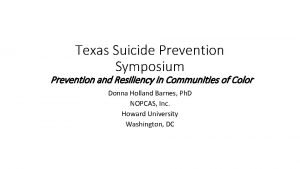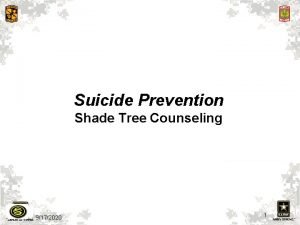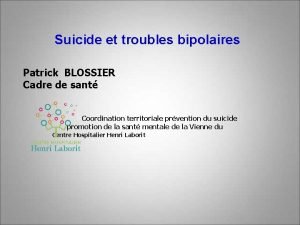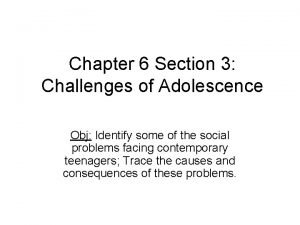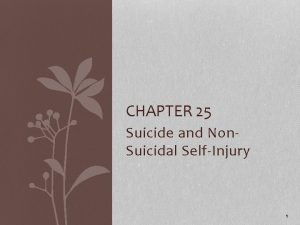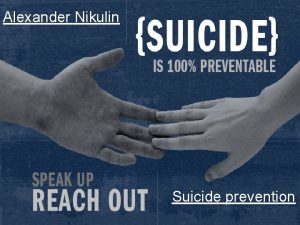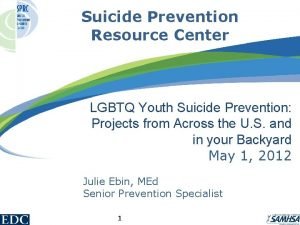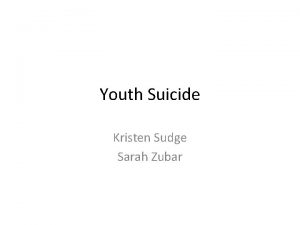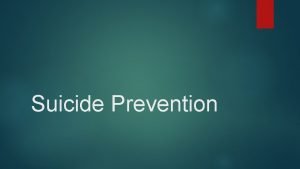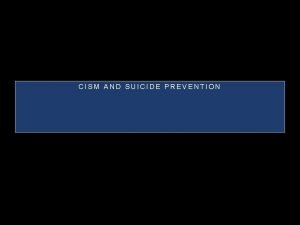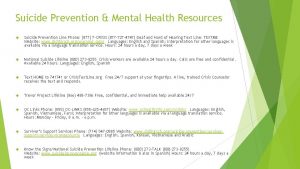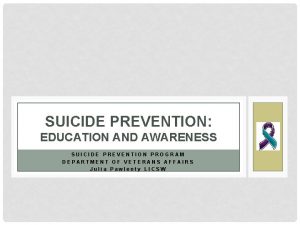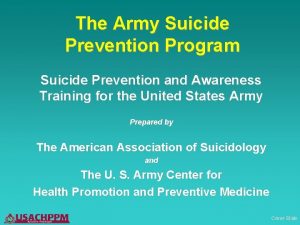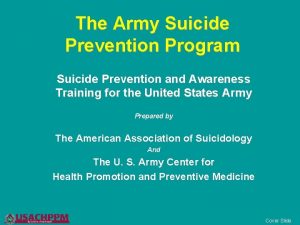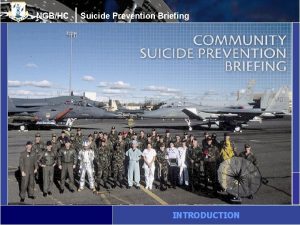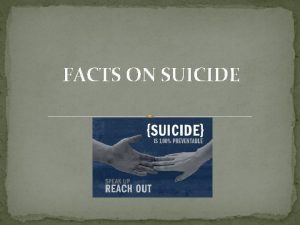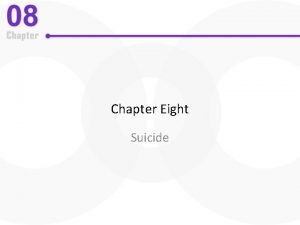Youth Suicide Prevention presentation Xenos Christian Fellowship June



























- Slides: 27

Youth Suicide Prevention presentation Xenos Christian Fellowship June 20, 2015 Denise Meine-Graham Joe Botti

Youth Suicide Prevention Goals for Today � Understanding scope of suicide problem � Depression � Dispel myths with facts � Risk factors & Warning signs � Equip you with resources 2

Facts & Figures Scope of Problem of Suicide

2013 National Facts � Over 41, 149 suicide deaths ◦ One person dies every 12. 8 minutes ◦ 77. 9% male / 22. 1% female � 10 th leading cause of death for adults � Suicide rates are highest among those ages 45 -64 � Older adults (65+) have second highest age group � For youth ages 15 -24, suicide is the 2 nd leading cause of death 4

Co-Occurring with Mental Health Problems � 90% of people who die by suicide have mental health and/or alcohol or drug problems ◦ Depression, Mood disorders, Bipolar, PTSD (post-traumatic stress disorder), Eating disorders � 80% of those who died by suicide talked about it 5

Suicide: Shhhh! � What makes suicide so hard to talk about? ◦ Societal factors that contribute to stigma about suicide � Stigma about having mental health problems keeps people from seeking help or even acknowledging the problem � Depression is greatest risk factor for suicide ◦ A disorder that can be treated—not something to be ashamed of, not a weakness 6

Depression Defined Thoughts Emotional Weight gain/loss Physical, Sleep problems body regulation Sense of tiredness, exhaustion Sad mood Loss of interest in pleasurable things, lack of motivation 6. Irritability, anger, negative overreaction 7. Confusion, loss of concentration, poor memory 8. Negative thinking 9. Withdrawal from friends and family 10. Sometimes, suicidal thoughts (DSM-IV-TR, 2000) 1. 2. 3. 4. 5. 7

Common Myths about Suicide

Myth 1 Talking about suicide increases risk of death by suicide � It is helpful to show the youth that you genuinely care. Research shows that asking about suicide provides relief to the suicidal person and does not increase risk. 9

Myth 2 A person who threatens suicide won’t really follow through � About 80% of people who die by suicide communicate verbal or behavioral warning signs. Talking about wanting to die is a very serious, clear warning sign. Youth often tell peers rather than adults. 10

Myth 3 Bullying causes suicide � There is no one “cause” of suicide. Suicide results from a complex interaction of genetic vulnerability, personality and coping styles, and traumatic and/or triggering events. Bullying may be a contributing risk factor for suicide. 11

Myth 4 Once a person decides to die, nothing can stop them � People who are suicidal want their overwhelming emotional pain to end. They are unable to see alternatives and feel hopeless. Most people want to be stopped. Treatment is highly effective for underlying depression, substance abuse, and other problems. 12

Risk Factors & Warning Signs

Risk Factors � Presence of mental health or alcohol/drug problems � Previous attempts � Non-suicidal self-injury � Recent severe stressor or “triggering event” ◦ Interpersonal conflict, break-ups, bullying, anniversary of a loved one’s death � Social isolation � Legal, discipline, school problems � Struggle with sexual orientation � Low self-esteem 14

Risk Factors � Childhood maltreatment, especially sexual abuse � Family history of: ◦ suicide attempts, completions ◦ mental health or alcohol/drug problems � Family instability, lack of communication � Economic stress on family � Firearms in household (access to method) � Aggressive, impulsive � Preoccupation with death � Unwilling or unable to seek help � Exposure to another’s suicide � Contagion, influence of media/web, celebs 15

Warning Signs � Expression of desire to harm self ◦ Direct or indirect �“I can’t go on any longer” �“I hate this life” �“Everyone would be better off without me” �“Life is not worth living” �“I want to die” �Any mention of suicide � Signs of depression � Giving away prized possessions 16

Warning Signs � Decline in hygiene, appearance � Withdrawal from family, friends � Saying goodbyes � Sudden happiness after long depression � Obsession with death, writing notes or poems � Drug and alcohol use 17

Your Intervention Helps

Practice What to Say “You seem pretty down”; “Do things seem hopeless to you? ”; “Have you ever thought it would be easier to be dead? ”; “Have you had suicidal thoughts? ”; “Are you having thoughts of hurting yourself? ” Remember, you cannot make someone suicidal by talking about it; If a person is already thinking of it he/she will probably be relieved that the secret is out If you get a ‘yes’ answer, don’t panic; ask; a few more questions 19

Listen and Be Open Talk openly Try to instill hope Encourage expression of feelings Use warning signs to get help as early as possible, not as a reason to exclude, isolate, or punish Stay calm, relaxed, & rational Recognize your limits 20

What to Avoid Moral judgments, argue, or lecture Encourage guilt: “How would your family feel? ” Promise confidentiality or reassurances “You’re luckier than most people” isn’t helpful Minimize the problem or offer simple solutions Dare the suicidal person Leave the person alone 21

Refer for Professional Help · · · · When a person exhibits signs of depression When risk is present (e. g. , specific plan, available means) Know your resources—Emergency Room & open access, suicide prevention lifeline Nat’l Suicide Prev Lifeline: 1 -800 -273 -TALK/8255 Local Suicide Prev Lifeline: 614 -221 -5445 Net. Care: 614 -276 -CARE/2273 Go to the nearest Emergency Room or Call 9 -1 -1 Nationwide Children’s Behavioral Health Hospital. Appt: 614 -355 -8080 The OSU Wexner Med Ctr Behavioral Health: Appt: 614 -293 -9600 22

Xenos Youth Worker Protocol Suicide is the second leading cause of death for youth between ages of 15 and 24. When a student discusses suicide, it’s something we don’t take lightly. What constitutes a serious threat? Although no disclosures should be minimized, if the student has a plan (time, place or method) then we must act immediately. 1. Do not promise to keep it a secret. 2. Try to remove any accessibility to the means; however, never try to physically remove a weapon from a suicidal person. You want them to surrender it voluntarily. 23

Xenos Youth Worker Protocol 3. Stay with them. Be positive. Suggest some alternatives. Remain calm and empathetic. Use questions to help separate and define the issues. This will help remove some of the confusion in their minds. Emphasize the temporary nature of the person's problem and that suicide is a permanent solution to a temporary problem. 4. Make sure the parents are informed. If a student has a plan, then in most cases, you should call the parents yourself. If the student doesn’t have a plan, but only passing thoughts, it is wise to persuade the student to tell his parents. Contact parents later to confirm the student has told them what they told you. If the parents of a minor already know about the danger and have the child in counseling, this could be adequate, but consult your sphere leader for advice. 24

Xenos Youth Worker Protocol 5. Refer suicide threats or ideas to outside professional counseling. We do not feel that Xenos leaders nor pastoral counselors are qualified to handle such dangerous situations. These cases need to be referred to a licensed medical professional, so immediate referral is imperative. 6. Also, endangered minors should be taken to a place of medical evaluation, either by you or their parents. With minors, please consult parents first if at all possible. • • • Ages 14 & under: Ages 15 -17: Ages 18 + : Nationwide Children’s Hosp. Ohio State Wexner Medical Center Net. Care 25

Xenos Youth Worker Protocol 7. Document the conversation within 48 hours and email it to your Sphere Leader and the Division Coordinator of Student Ministries. 8. The documentation should include: • The student’s first and last name • The student’s age • A description of what was disclosed • A description of what you advised any action you took, including any communication to the parents. • Consult your sphere leader with any questions. 26

Youth Suicide Prevention Q&A 27
 Xenos christian fellowship
Xenos christian fellowship Xenos christian fellowship
Xenos christian fellowship Primary prevention secondary prevention tertiary prevention
Primary prevention secondary prevention tertiary prevention Mad acronym suicide prevention
Mad acronym suicide prevention Chapter 5 lesson 3 suicide prevention answer key
Chapter 5 lesson 3 suicide prevention answer key Suicide prevention chain teach
Suicide prevention chain teach Texas suicide prevention symposium
Texas suicide prevention symposium Suicide prevention sink
Suicide prevention sink Shadetree army
Shadetree army Prévention du suicide
Prévention du suicide Suicide prevention month quotes
Suicide prevention month quotes Army suicide prevention training
Army suicide prevention training Prévention suicide
Prévention suicide Youth suicide research consortium
Youth suicide research consortium Christian friendship fellowship
Christian friendship fellowship Evangel christian fellowship
Evangel christian fellowship Evangel christian fellowship
Evangel christian fellowship Jesus humunculi
Jesus humunculi Fruitkistjes xenos
Fruitkistjes xenos Xenos god
Xenos god Youth desk
Youth desk Sara calixto suicide girl
Sara calixto suicide girl Citadel counseling center
Citadel counseling center Rvguev death
Rvguev death Drug intoxication icd-10
Drug intoxication icd-10 Egoistic suicide
Egoistic suicide What are the challenges of adolescence
What are the challenges of adolescence Chapter 25 suicide and nonsuicidal self injury
Chapter 25 suicide and nonsuicidal self injury






